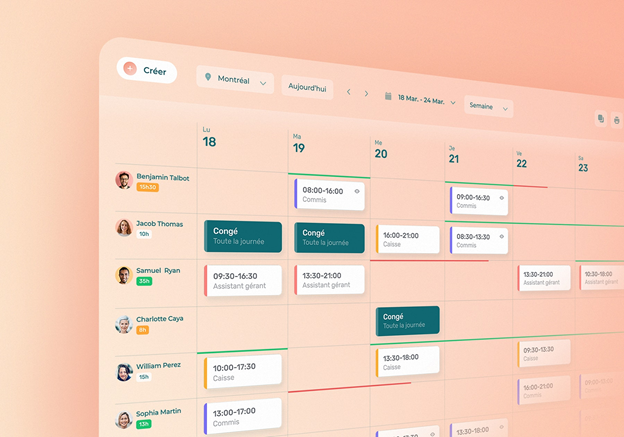How To Make Your Retail Employee Scheduling Easier
Retail employee scheduling can be a hassle. Trying to keep track of who is working when and where can be difficult, especially if your store has multiple locations or shifts. In this blog post, we will discuss some tips that will make retail employee scheduling easier for you and your employees!
6 Key Ways To Make Your Retail Employee Scheduling Easier
1. Use a Retail Schedule Software
6 Key Ways To Make Your Retail Employee Scheduling Easier
1. Use a Retail Schedule Software
|
One way to make retail employee scheduling easier is by using retail schedule software. Scheduling software can help you keep track of your employees' availability, shift preferences, and skill sets. This information can be used to create a more efficient schedule that meets the needs of your business.
Scheduling software can make your life a lot easier when it comes to making sure that your employees are where they need to be and when they need to be there. |
Here are some of the benefits of using the scheduling software for retail employee scheduling:
Before choosing a retail employee scheduling software, you should consider the following:
2. Communicate with Your Employees
- You can easily see who is available and when. This makes it easy to schedule around everyone’s availability.
- You can communicate with your employees easily through the software. This way, if there are any changes to the schedule, everyone will be on the same page.
- The software keeps track of all of the shifts so you don’t have to. This way, you can focus on other aspects of running your business.
- It can also help you create a more efficient and effective schedule for your retail business.
- Software like Agendrix and Zip Schedules offer a free trial so that you can test out the features before committing to anything. This is the perfect way to see if scheduling software is right for you and your business.
Before choosing a retail employee scheduling software, you should consider the following:
- The size of your business. The best retail employee scheduling software will be able to accommodate businesses of all sizes, from small mom-and-pop shops to large national chains.
- Your budget. Look for the one that fits within your budget.
- Key features: Make sure that it is most important to you and your business.
2. Communicate with Your Employees
|
When it comes to retail employee scheduling, one of the most important things you can do is communicate with your employees. Let them know their schedules in advance so they can plan accordingly. Be available to answer any questions or concerns they may have about their shifts. By communicating openly and frequently with your employees, you will be able to create a better work environment for everyone involved.
Additionally, make sure to let your employees know their schedules in advance so they can plan accordingly. |
Be available to answer any questions or concerns they may have about their shifts. By communicating openly and frequently with your employees, you will be able to create a better work environment for everyone involved.
If you take the time to communicate with your employees and make sure they are happy with their schedules, you will see a positive impact on your business as a whole. Employees who are treated well and feel like they are valued by their employer are more likely to go above and beyond in their jobs. They’re also less likely to call out sick or quit, which can save you a lot of time and money in the long run.
So if you want to make your retail business run more smoothly, start by communicating with your employees about their schedules. It’s one of the best things you can do for your business.
3) Allow Shift Swapping Among The Employees
Retail employees are often given very little say in their work schedules. This can be frustrating for them, especially when they have other commitments outside of work. Allowing employees to swap shifts with each other can help to make the scheduling process easier and fairer for everyone involved.
When employees are able to swap shifts, it takes some of the pressure off of the scheduler. They no longer have to worry about finding someone to cover a shift at the last minute. Employees who are interested in swapping shifts can simply sign up for the open shift on a first-come, first-serve basis.
This system also allows employees to have more control over their own schedules. If they know they have a conflict on a certain day, they can try to swap their shift with someone else. This can help to make the work schedule more flexible and accommodating for everyone involved.
Allowing employees to swap shifts can be a great way to improve the scheduling process for both employees and managers alike. It takes some of the pressure off of the scheduler and gives employees more control over their own schedules.
4) Always Plan Ahead
If you take the time to communicate with your employees and make sure they are happy with their schedules, you will see a positive impact on your business as a whole. Employees who are treated well and feel like they are valued by their employer are more likely to go above and beyond in their jobs. They’re also less likely to call out sick or quit, which can save you a lot of time and money in the long run.
So if you want to make your retail business run more smoothly, start by communicating with your employees about their schedules. It’s one of the best things you can do for your business.
3) Allow Shift Swapping Among The Employees
Retail employees are often given very little say in their work schedules. This can be frustrating for them, especially when they have other commitments outside of work. Allowing employees to swap shifts with each other can help to make the scheduling process easier and fairer for everyone involved.
When employees are able to swap shifts, it takes some of the pressure off of the scheduler. They no longer have to worry about finding someone to cover a shift at the last minute. Employees who are interested in swapping shifts can simply sign up for the open shift on a first-come, first-serve basis.
This system also allows employees to have more control over their own schedules. If they know they have a conflict on a certain day, they can try to swap their shift with someone else. This can help to make the work schedule more flexible and accommodating for everyone involved.
Allowing employees to swap shifts can be a great way to improve the scheduling process for both employees and managers alike. It takes some of the pressure off of the scheduler and gives employees more control over their own schedules.
4) Always Plan Ahead
|
One major pain point for retail employees is last-minute scheduling changes. When retailers don't plan ahead, employees are left scrambling to find childcare or adjust their work-life balance on short notice. This can lead to high levels of employee turnover and ultimately hurt the bottom line.
Fortunately, there are some steps that retailers can take to make Retail Employee Scheduling easier. |
By planning ahead and communicating with employees early and often, retailers can avoid last-minute scheduling changes and keep their employees happy. Here are a few tips:
By following these tips, retailers can make Retail Employee Scheduling easier and avoid many of the pitfalls that come with last-minute changes. By taking the time to plan ahead, retailers can keep their employees happy and reduce turnover.
5) Keep Track of Overtime
If you’re like most retail employers, you probably don’t give much thought to how overtime impacts your business. After all, what’s a little extra time working here and there?
The truth is, though, that over time can have a significant impact on your business – both in terms of cost and productivity. And when it comes to retail employee scheduling, keeping track of overtime can be the key to making sure your schedule is both effective and compliant.
So how can you keep track of overtime when creating your retail employee schedule? Here are a few tips:
By following these tips, you can help ensure that your retail employee schedule is compliant with overtime regulations. And by keeping track of overtime, you can also help keep your costs down and also make your employee scheduling easier.
6) Make Sure Your Employees are Properly Classified
The first step is to look at the number of hours each employee is available to work. This will help you determine which employees can work which shifts. For example, if you have an employee who is only available for 20 hours a week, they will not be able to work a full-time shift. Once you know the availability of your employees, you can start to create their schedules.
If you have part-time and full-time employees, it is important to create separate schedules for them. This way, you can ensure that all of your employees are getting the appropriate number of hours. Part-time employees should not be working more than 32 hours per week and full-time employees should not be working less than 40 hours per week.
Creating separate schedules for part-time and full-time employees will also help you to avoid scheduling conflicts. For example, if you have an employee who is only available for 20 hours per week, they will not be able to work a full-time shift. By creating separate schedules, you can ensure that all of your employees are getting the appropriate number of hours.
Once you have created the schedules, you can start to fill in the shifts. When filling in the shifts, it is important to consider the skills of each employee. For example, if you have an employee who is trained in customer service, they should be scheduled for shifts that involve interacting with customers.
It is also important to remember that schedules can change from week to week. For example, if you have an employee who is only available for 20 hours per week, they may not be available to work the same shift every week. As such, it is important to be flexible when creating schedules.
By taking the time to properly classify your employees and create separate schedules, you can make the process of retail employee scheduling much easier.
Conclusion
Scheduling your retail employees doesn't have to be a daunting task. By using the right tools and following the tips that we have described in this article, you can make the process easier and ensure that your employees are happy and productive. Have you tried any of these methods for scheduling? What has worked best for you?
- Plan your schedule at least two weeks in advance. This will give you time to make adjustments if needed, but it will also allow your employees to plan their lives around their work schedule.
- Communicate with your employees regularly. If you need to make changes to the schedule, let your employees know as soon as possible.
- Be flexible when possible. If an employee has a conflict, try to work around it if you can.
By following these tips, retailers can make Retail Employee Scheduling easier and avoid many of the pitfalls that come with last-minute changes. By taking the time to plan ahead, retailers can keep their employees happy and reduce turnover.
5) Keep Track of Overtime
If you’re like most retail employers, you probably don’t give much thought to how overtime impacts your business. After all, what’s a little extra time working here and there?
The truth is, though, that over time can have a significant impact on your business – both in terms of cost and productivity. And when it comes to retail employee scheduling, keeping track of overtime can be the key to making sure your schedule is both effective and compliant.
So how can you keep track of overtime when creating your retail employee schedule? Here are a few tips:
- Pay close attention to hours worked each week. If an employee consistently works more than 40 hours per week, they may be eligible for overtime pay.
- Keep track of time off. If an employee takes time off during their shift, they may be entitled to overtime pay for the hours they worked before taking their break.
By following these tips, you can help ensure that your retail employee schedule is compliant with overtime regulations. And by keeping track of overtime, you can also help keep your costs down and also make your employee scheduling easier.
6) Make Sure Your Employees are Properly Classified
The first step is to look at the number of hours each employee is available to work. This will help you determine which employees can work which shifts. For example, if you have an employee who is only available for 20 hours a week, they will not be able to work a full-time shift. Once you know the availability of your employees, you can start to create their schedules.
If you have part-time and full-time employees, it is important to create separate schedules for them. This way, you can ensure that all of your employees are getting the appropriate number of hours. Part-time employees should not be working more than 32 hours per week and full-time employees should not be working less than 40 hours per week.
Creating separate schedules for part-time and full-time employees will also help you to avoid scheduling conflicts. For example, if you have an employee who is only available for 20 hours per week, they will not be able to work a full-time shift. By creating separate schedules, you can ensure that all of your employees are getting the appropriate number of hours.
Once you have created the schedules, you can start to fill in the shifts. When filling in the shifts, it is important to consider the skills of each employee. For example, if you have an employee who is trained in customer service, they should be scheduled for shifts that involve interacting with customers.
It is also important to remember that schedules can change from week to week. For example, if you have an employee who is only available for 20 hours per week, they may not be available to work the same shift every week. As such, it is important to be flexible when creating schedules.
By taking the time to properly classify your employees and create separate schedules, you can make the process of retail employee scheduling much easier.
Conclusion
Scheduling your retail employees doesn't have to be a daunting task. By using the right tools and following the tips that we have described in this article, you can make the process easier and ensure that your employees are happy and productive. Have you tried any of these methods for scheduling? What has worked best for you?






